|
4th Grade Performance Task
Contributed by: New Standards (NS)
Description:
Students gather original data throughout two performance tasks. They
analyze their results along with given data to determine which eggs
are best for rocky cliff environments.
The task assesses ability to perform tasks, make simple observations,
collect and organize data, and analyze results.
This task is designed to take students approximately 55 minutes
to complete.
Overall Task Content Area:
- Physical and Life Science
Specific Knowledge Areas:
- Organisms and their environments
- Position and motion of objects
Performance Expectations:
- conducting investigations
- using equipment
- gathering, organizing, and representing data
- formulating conclusions from investigational data
- applying scientific principles to develop explanations and solve
new problems
National Science Education Standards:
4 A SI 1: Abilities necessary to do scientific inquiry:
Grades K-4
1.3 Employ simple equipment and tools to gather data and
extend the senses. In early years, students develop simple skills,
such as how to observe, measure, cut, connect, switch, turn on and
off, pour, hold, tie, and hook. Beginning with simple instruments,
students can use rulers to measure the length, height, and depth
of objects and materials; thermometers to measure temperature; watches
to measure time; beam balances and spring scales to measure weight
and force; magnifiers to observe objects and organisms; and microscopes
to observe the finer details of plants, animals, rocks, and other
materials. Children also develop skills in the use of computers
and calculators for conducting investigations.
1.4 Use data to construct a reasonable explanation. This
aspect of the standard emphasizes the studentsí thinking as they
use data to formulate explanations. Even at the earliest grade levels,
students should learn what constitutes evidence and judge the merits
or strength of the data and information that will be used to make
explanations. After students propose an explanation, they will appeal
to the knowledge and evidence they obtained to support their explanations.
Students should check their explanations against scientific knowledge,
experiences, and observations of others.
1.5 Communicate investigations and explanations. Students
should begin developing the abilities to communicate, critique,
and analyze their work and the work of other students. This communication
might be spoken or drawn as well as written.
4 B PS 2: Position and motion of objects: Grades K-4
2.2 An object's motion can be described by tracing and
measuring its position over time.
4 C LS 3: Organisms and their environments: Grades K-4
3.2 An organismís patterns of behavior are related to the
nature of that organismís environment, including the kinds and numbers
of other organisms present, the availability of food and resources,
and the physical characteristics of the environment. When the environment
changes, some plants and animals survive and reproduce, and others
die or move to new locations.
(Use the "hot" link on the PALS home page
to check the full text of related National Science Education Standards,
if desired.)
National Council of Teachers of Mathematics:
DAP3: Develop and evaluate inferences
and predictions that are based on data:
Grades pre K-5 b. propose and justify conclusions
and predictions that are based on data and design studies to further
investigate the conclusions ore predictions
GEO1: Analyze characteristics and properties of two-
and three-dimensional shapes and develop mathematical arguments
about geometric relationships:
Grades pre K-5 a. a. recognize, name, build, draw, compare,
and sort two- and three-dimensional shapes
Grades pre K-5 d. identify, compare, and analyze attributes
or two- and three-dimensional shapes and develop vocabulary to describe
the attributes
MEAS2: Apply appropriate techniques, tools, and formulas
to determine measurements:
Grades pre K-5 d. develop common referents for measures to
make comparisons and estimates
Grades pre K-5 g. select and use benchmarks to estimate measurements
RP3: Develop and evaluate mathematical arguments and
proofs:
Grades pre K-5
COM3: Analyze and evaluate the mathematical thinking
and strategies of others:
Grades pre K-5
General Instructions to the Teacher:
This task is designed to take students approximately 55 minutes
to complete.
Students will be working individually during this exercise.
Students should be ready to work as soon as the period begins.
The materials should be set out at each lab station, if possible.
A central supply area, if needed, should be easily accessible. All
supplies should be clearly labeled.
Materials for Bird Eggs:
The teacher will need:
- Various white powders (students are looking for varying degrees
of "bubbles" - calcium carbonite, for example, will produce many
bubbles with vinegar.)
- Testing solution (e.g. vinegar)
- Vials or containers
- Solid wooden eggs- three shapes: sphere, oblong, and "egg" shaped
(If they aren't solid they don't roll consistently)
- Well trays (may substitute small plastic cups or bowls)
- Scoopers or spoons
- Marking pen
- Labels
At this station students should have:
- Eggs X, Y, and Z
- Cardboard ramp
- Egg shell samples X, Y, and Z
- 4 well tray
- 3 scoopers
- Egg shell testing solution
Advance Preparation:
- Prepare egg shell samples and place in vials.
- Label vials accordingly.
- Label eggs - sphere = X, oblong = Y, "egg" shaped = Z
- Prepare testing solution.
- Label solution "Egg shell Testing Solution"
- Cut ramps from cardboard: 2 inch by 4 inch squares.
- Draw folding line 3/4 inch from one end.
Safety:
- Caution students not to taste or smell the egg shell solutions.
- Discuss procedures for picking up eggs from the floor if dropped.
Beware of knocking heads.
- Be careful.
- Teachers and students should always exercise appropriate safety
precautions and utilize appropriate laboratory safety procedures
and equipment when working on science performance tasks.
Extensions/modifications:
Advanced Preparation Set Up:
| Prepare vials of powder and label (Z sizzles most, X least).
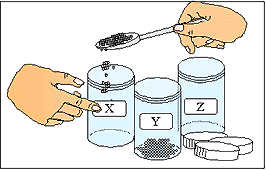
|
Label eggs.
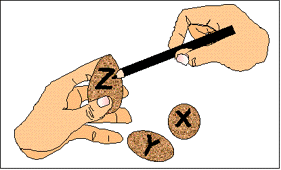
|
| Prepare testing solution and label.
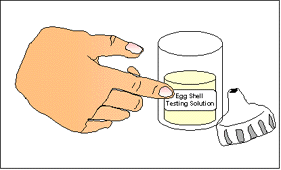
|
Cut cardboard ramp.
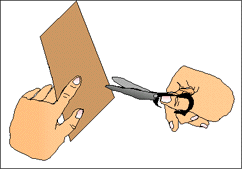
|
| Draw starting line.
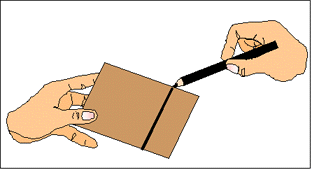
|
Organize student work station.
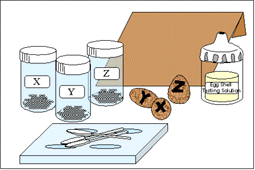
|
|







